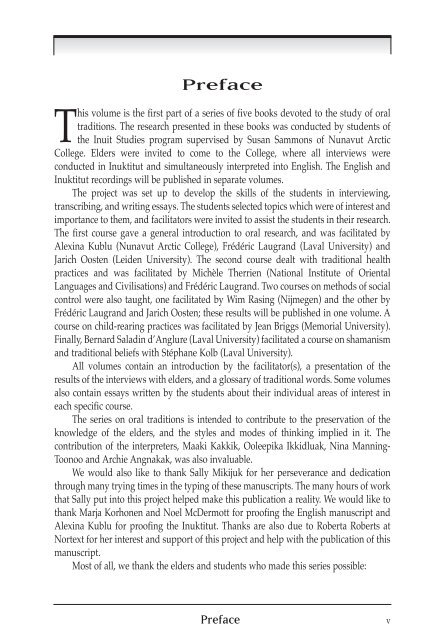Introduction-E
Introduction-E
Introduction-E
You also want an ePaper? Increase the reach of your titles
YUMPU automatically turns print PDFs into web optimized ePapers that Google loves.
Preface<br />
This volume is the first part of a series of five books devoted to the study of oral<br />
traditions. The research presented in these books was conducted by students of<br />
the Inuit Studies program supervised by Susan Sammons of Nunavut Arctic<br />
College. Elders were invited to come to the College, where all interviews were<br />
conducted in Inuktitut and simultaneously interpreted into English. The English and<br />
Inuktitut recordings will be published in separate volumes.<br />
The project was set up to develop the skills of the students in interviewing,<br />
transcribing, and writing essays. The students selected topics which were of interest and<br />
importance to them, and facilitators were invited to assist the students in their research.<br />
The first course gave a general introduction to oral research, and was facilitated by<br />
Alexina Kublu (Nunavut Arctic College), Frédéric Laugrand (Laval University) and<br />
Jarich Oosten (Leiden University). The second course dealt with traditional health<br />
practices and was facilitated by Michèle Therrien (National Institute of Oriental<br />
Languages and Civilisations) and Frédéric Laugrand. Two courses on methods of social<br />
control were also taught, one facilitated by Wim Rasing (Nijmegen) and the other by<br />
Frédéric Laugrand and Jarich Oosten; these results will be published in one volume. A<br />
course on child-rearing practices was facilitated by Jean Briggs (Memorial University).<br />
Finally, Bernard Saladin d’Anglure (Laval University) facilitated a course on shamanism<br />
and traditional beliefs with Stéphane Kolb (Laval University).<br />
All volumes contain an introduction by the facilitator(s), a presentation of the<br />
results of the interviews with elders, and a glossary of traditional words. Some volumes<br />
also contain essays written by the students about their individual areas of interest in<br />
each specific course.<br />
The series on oral traditions is intended to contribute to the preservation of the<br />
knowledge of the elders, and the styles and modes of thinking implied in it. The<br />
contribution of the interpreters, Maaki Kakkik, Ooleepika Ikkidluak, Nina Manning-<br />
Toonoo and Archie Angnakak, was also invaluable.<br />
We would also like to thank Sally Mikijuk for her perseverance and dedication<br />
through many trying times in the typing of these manuscripts. The many hours of work<br />
that Sally put into this project helped make this publication a reality. We would like to<br />
thank Marja Korhonen and Noel McDermott for proofing the English manuscript and<br />
Alexina Kublu for proofing the Inuktitut. Thanks are also due to Roberta Roberts at<br />
Nortext for her interest and support of this project and help with the publication of this<br />
manuscript.<br />
Most of all, we thank the elders and students who made this series possible:<br />
Preface<br />
v


